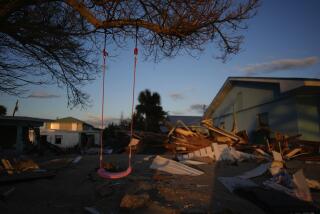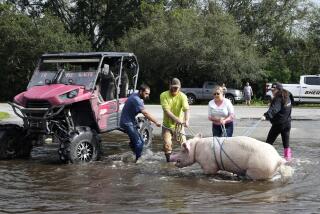The incredible stories of the die-hards who looked Irma in the face — and stayed
As Hurricane Irma barreled into Key West, Peter Borch stood atop the oldest guesthouse in the city, a converted Victorian mansion built in 1880, to film the unfolding mayhem.
Storm gusts bent nearby palm trees nearly in half, stripping and scattering fronds down empty streets. The horizon was nearly obscured by a white wall of surf roaring in.
“The eyewall is about to hit here in Key West. No power. Trees down. No flooding,” Borch, 31, shouted to be heard over the wind.
Then he shifted focus to a porch below, where an older man sat, shirtless, sipping coffee from a mug, oblivious to the onslaught.
From initial reports Sunday, it appeared that the Florida Keys had taken a pounding but dodged the sort of catastrophic disaster that had been widely expected as Irma roared north out of the Caribbean. But there were reports of missing people, and fears for what might be found in the light of day on Monday.
Keys residents are a hardy, proudly eccentric bunch, accustomed to surviving storms. Many refused to evacuate ahead of Hurricane Irma, including residents at the tip of the island chain in Key West known as conchs. The keeper of Ernest Hemingway’s historic home stayed put to care for his brood of six-toed cats. Watering holes like the Blue Macaw stayed open, offering a drink special called the “Bloody Irma” (five shots of Tito’s vodka). But as the storm descended Sunday, some denizens reconsidered and headed for shelters of last resort like a school on Sugarloaf Key. Others hunkered down, set up live feeds and promised to stay in touch.
Video: Times coverage of Hurricane Irma
One holdout filmed himself nearly getting washed away by storm surf striking the red and yellow buoy at the southernmost point of U.S. Route 1. Florida snowbirds and other island regulars posted queries online: How were the federally protected Key deer faring? Key West’s roaming roosters? Initial reports were good.
Then the power went out, cell service ceased and with it, the live feeds. Only those with satellite phones and land lines could stay in touch with the outside world.
Those at the Sugarloaf School were among the lucky few with a satellite phone, and used it to report that those sheltering there had survived the storm unscathed. Volunteer rescuers used an app on their cellphones called Zello to report what else they were seeing.
“I’m in Key West and we’re all right down here. I never do run from a storm,” said a man who identified himself as P.J.
Judy Cox searched online for signs of her friend, Borch, one of several Key West neighbors who decided to weather the storm.
She last heard from him at 9 a.m., about an hour after he posted his last video. She said he told her “it was windy and not a lot of flooding. Some trees down and no power since last night.”
Now, she was worried.
She had trouble reaching another friend, a boat captain, who was weathering the storm by Schooner Wharf, she said.
“Last I heard he was on his boat,” Cox said.
In many cases, however, people were unreachable simply because they had lost cellphone service. Relatives even had trouble reaching Key West Mayor Craig Cates: He doesn’t have a land line.
Longtime Key West resident artist Richard “Dick” Matson answered his land line around noon.
“I’m cooking breakfast in what’s left of my home,” he said.
His shutters had been damaged, and he had not been able to assess the rest of the storm’s impact because it was still raging outside.
“I’m fine,” Matson, 81, said by phone as he cooked his eggs. “Better than I would be if I was out there.”
Why did he stay?
“I stayed through five storms: Hugo, Bob, George and Andrew. I’ve stayed here 40 years. This is my home and I’m going to stay here until I die,” he said.
As for how Irma compared to Hurricane Andrew in 1992, he said, “It’s bad.”
Cox had evacuated Wednesday, first to Tampa, then farther north along the coast to Wilmington, N.C., after the storm’s path shifted Thursday.
Some of her friends booked flights out of the Key West International Airport only to see them canceled at the last minute, she said.
By Saturday, she said, many of those who stayed were afraid to leave. “The thought of getting stuck for hours in traffic with no gas was more terrifying to people than staying at home,” she said.
As the storm approached, emergency managers for Monroe County had to move their headquarters farther north from Marathon, which was hard hit.
Larry Kahn, editor of the Keynoter newspaper, reported from a shelter at Marathon High School that the school had lost power and water as the neighborhood became submerged from the storm surge.
“Everything is underwater, I mean everything,” Kahn wrote, noting that about 50 people at the shelter expected to be stranded for days. “Everyone here seems to be just walking around in a fog.”
About 500 guests stayed at the Key West Marriott Beachside Hotel, which weathered the storm without major damage. “The building is fine. We are standing strong. We have no power. We have no water. We have no Internet. But we have our lives,” Esa Sawyer, a guest service agent at the hotel, said by phone.
Among those who stayed in Key West was Bill South, a meteorologist with the National Weather Service, who received reports of “extensive damage” in Big Pine Key, west of Marathon, including a roof knocked into a driveway.
“Someone came in and told us there’s a roof missing from one of the hotels on North Roosevelt Boulevard, but we can’t get anybody out there,” he said.
South said it was difficult to gauge damage across the Keys because “only the most dire emergency services are going out.”
“Historically in the Florida Keys, this is going to rank right up there in the top three, the most damaging” storms, he said, including Hurricane Donna in 1960 and the Labor Day Hurricane in 1935.
Winds gusted to 120 mph in Big Pine Key on Sunday and the storm surge rose to 14 feet in Marathon and Cudjoe Key to the west, South said, noting that surges above 10 feet can destroy buildings.
“The storm surge damage will probably be most devastating when it’s all said and done,” he said, with the most serious damage probably confined to the area from Big Coppitt Key east to Marathon.
Emergency managers had received a report of only one fatality in the Keys, a man who crashed his vehicle in Marathon. His name had not been released pending family notification, South said.
A major concern for both those who stayed and those who evacuated: How much damage had the storm done to the series of bridges that connect the Keys via U.S. Route 1?
“If U.S. 1 is compromised in any way, we could be out of contact for some time,” South said.
The storm damaged some areas, including a bridge at Snake Creek in Islamorada, he said, but, “Monroe County emergency services got out there and checked it and it’s all right” — still passable.
State crews were expected to check other bridges in the Keys on Monday.
“It’s going to be a massive cleanup,” South said.
Monroe County Commissioner Heather Carruthers evacuated before the storm to Orlando with her wife and children, but remained involved with emergency management, which held meetings to discuss recovery efforts Sunday as storm winds and surge subsided. One of the first goals was to reopen medical facilities shuttered during the storm, she said.
“Clearly, we’re going to need some help,” she said. “Marathon in particular took a lot of water.”
Carruthers said the National Guard would be flying aid into Marathon starting late Sunday on C-130 planes. On Facebook, she advised residents who had evacuated not to return until they receive a message that it’s safe. “There is no water, electricity or medical support at this time,” she wrote.
But as Irma headed north toward Tampa, a much larger metropolis unaccustomed to hurricanes, Carruthers said her community had been well prepared, not just by emergency managers, but by years of experience living at the country’s southernmost point.
“We’re a pretty resilient bunch in the Keys, and we will rebuild,” Carruthers said. “It’s always a little challenging when you’re a 120 mile-long string of islands. But we have a lot of experience recovering from these kinds of storms.”
ALSO
President Trump approves major disaster declaration as Irma’s destruction continues to unfold
Hurricane Irma cuts power to more than 2 million in South Florida, FPL warns of slow recovery
Hurricane Harvey hit this high school hard, but its football team fights on
More to Read
Sign up for Essential California
The most important California stories and recommendations in your inbox every morning.
You may occasionally receive promotional content from the Los Angeles Times.











